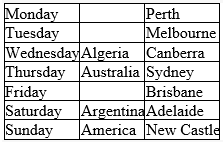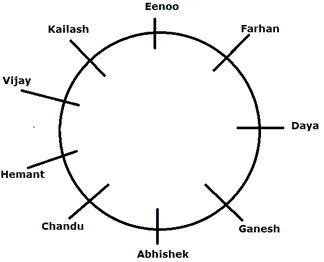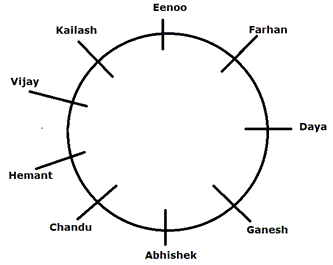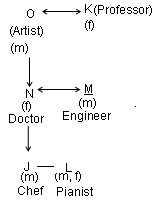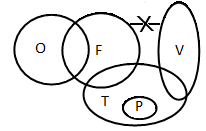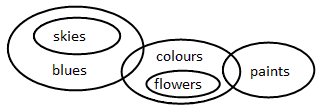IBPS SO Prelims Mock Test - 7 - Bank Exams MCQ
30 Questions MCQ Test - IBPS SO Prelims Mock Test - 7
Directions: In making decisions about important questions, it is desirable to be able to distinguish between strong and weak arguments in so far as they are related to the question. Weak arguments may not be directly related to the question, may be of minor importance, or may be related to some insignificant aspect of the question. The question given below is followed by two arguments numbered I and II. Decide which of the given arguments is/are strong, and then mark your answer accordingly.
Statement: Should the age for issuing a driving license be decreased?
Arguments:
I. Yes, the earlier one starts driving, the easier it is to learn.
II. No, children below the stipulated age cannot apprehend the dangers associated with driving.
In a class, Karthik's rank is 17th from the top and 28th from the bottom. How many students are there in the class?
Directions: In the question below, a statement is given, followed by two courses of action numbered I and II. A course of action is a practicable and feasible step or administrative decision to be taken for follow-up, improvement, or further action in regard to the problem, policy, etc. On the basis of the information given in the statement, you have to assume everything in the statement to be true and decide which of the suggested courses of action follow(s) for pursuing.
Statement: Tax revenues almost always fall short of governments expenditure.
Courses of Action:
I. The Indian government should widen the tax net.
II. The government should devise innovative ways of taxation to makeup the deficit.
Direction: Study the information given below and answer the questions based on it.
An international level meeting is going to take place in Australia. Different nations are participating in it viz. Afghanistan, Algeria, Albania, America, Austria, Argentina and Australia. There will be seminars as well where each country will host seminars in different cities of Australia. Canberra, Perth, Melbourne, Sydney, Brisbane, Adelaide and New Castle are the seven cities where seminars will take place. Seminars will start from Monday and end on Sunday.Argentina will be hosting at Adelaide, but neither on Friday nor on Monday. The host country will host the seminar at Sydney on Thursday. There is a gap of one day between the seminars of Australia and Argentina. Algeria will host at Canberra on Wednesday. Afghanistan will host at Perth. America will host on the last day of the week. The seminar on Monday will not take place in Brisbane. The seminar at New Castle will be on Sunday. The seminar in Melbourne will take place on Tuesday. No seminar will take place in Perth on Tuesday or Friday.
When will the seminar at Perth take place?
Directions: The problem below consists a statement followed by three assumptions I, II and III. An assumption is something supposed or taken for granted. You have to consider the statement and the following assumptions, and decide which of the assumptions is/are implicit in the statement.
Statement: Stereoscopic 3D technology tricks the brain into believing it is viewing a real scene rather than a flat image on a screen.
Assumptions:
I. Images on the screen can be more than just flat.
II. A real image is a 3D image, unlike a flat image.
III. Technology can trick the brain.
Direction: The questions are based on the following letters/number/symbols arrangement. Study it carefully answer the following question.
L N 7 $ W E 8 ¤ 3 C © Z 2 Q A @ 6 T # 2 J 1 F K 9 I % D 4 P
Q. How many such symbols are there in the arrangement, each of which is immediately preceded by a number?
Directions: Read the given information and answer the question.
There is a family of seven members A, B, C, D, E, F and G, who are standing in a row from left to right (the one standing at the left end is called 1st and the one standing at the right end is called 7th). Their professions are IPS Officer, Librarian, Social Worker, IAS Officer, Housewife, Commissioner and Student, not necessarily in the same order. The third person is the Housewife, D is not the Commissioner, and stands after the person who immediately follows E. A is the Social Worker. The IPS Officer stands sixth. The Librarian stands to the immediate left of the Commissioner. G stands to the immediate right of F and to the immediate left of B. E, the Student, stands fifth.
Q. What is the profession of the person standing second to the left of B?
Directions: Read the given information and answer the question.
There is a family of seven members A, B, C, D, E, F and G, who are standing in a row from left to right (the one standing at the left end is called 1st and the one standing at the right end is called 7th). Their professions are IPS Officer, Librarian, Social Worker, IAS Officer, Housewife, Commissioner and Student, not necessarily in the same order. The third person is the Housewife, D is not the Commissioner, and stands after the person who immediately follows E. A is the Social Worker. The IPS Officer stands sixth. The Librarian stands to the immediate left of the Commissioner. G stands to the immediate right of F and to the immediate left of B. E, the Student, stands fifth.
Q. Which of the following pairs correctly matches the person with his/her profession?
Directions: Read the given information and answer the question.
There is a family of seven members A, B, C, D, E, F and G, who are standing in a row from left to right (the one standing at the left end is called 1st and the one standing at the right end is called 7th). Their professions are IPS Officer, Librarian, Social Worker, IAS Officer, Housewife, Commissioner and Student, not necessarily in the same order. The third person is the Housewife, D is not the Commissioner, and stands after the person who immediately follows E. A is the Social Worker. The IPS Officer stands sixth. The Librarian stands to the immediate left of the Commissioner. G stands to the immediate right of F and to the immediate left of B. E, the Student, stands fifth.
Q. Who is standing between G and A?
Directions: Read the given information and answer the question.
There is a family of seven members A, B, C, D, E, F and G, who are standing in a row from left to right (the one standing at the left end is called 1st and the one standing at the right end is called 7th). Their professions are IPS Officer, Librarian, Social Worker, IAS Officer, Housewife, Commissioner and Student, not necessarily in the same order. The third person is the Housewife, D is not the Commissioner, and stands after the person who immediately follows E. A is the Social Worker. The IPS Officer stands sixth. The Librarian stands to the immediate left of the Commissioner. G stands to the immediate right of F and to the immediate left of B. E, the Student, stands fifth.
Q. The person standing to the immediate left of D is
Directions: Read the given information and answer the question.
There is a family of seven members A, B, C, D, E, F and G, who are standing in a row from left to right (the one standing at the left end is called 1st and the one standing at the right end is called 7th). Their professions are IPS Officer, Librarian, Social Worker, IAS Officer, Housewife, Commissioner and Student, not necessarily in the same order. The third person is the Housewife, D is not the Commissioner, and stands after the person who immediately follows E. A is the Social Worker. The IPS Officer stands sixth. The Librarian stands to the immediate left of the Commissioner. G stands to the immediate right of F and to the immediate left of B. E, the Student, stands fifth.
Q. Who is standing 1st?
Six friends A, B, C, D, E and F are sitting in a row facing East. ‘C’ is between ‘A’ and ‘E’. ‘B’ is just to the right of ‘E’ but to the left of ‘D’. ‘F’ is not at the right end. How many persons are to the right of ‘E’?
Directions: Study the given information carefully and answer the question.
Abhishek, Vijay, Chandu, Daya, Eenoo, Farhan, Ganesh, Hemant and Kailash are sitting around a circular table facing the center. Chandu is second to the left of Ganesh, who is fourth to the right of Vijay. Chandu is fourth to the left of Farhan and Farhan is second to the left of Kailash. Kailash is fourth to the left of Abhishek. Daya is not an immediate neighbuor of Kailash and Vijay. Hemant is third to the right of Eenoo.
If all of them turn around and start facing outside while sitting at the same position, who will be sitting third to the right of Abhishek?
Directions: Study the given information carefully and answer the question.
Abhishek, Vijay, Chandu, Daya, Eenoo, Farhan, Ganesh, Hemant and Kailash are sitting around a circular table facing the center. Chandu is second to the left of Ganesh, who is fourth to the right of Vijay. Chandu is fourth to the left of Farhan and Farhan is second to the left of Kailash. Kailash is fourth to the left of Abhishek. Daya is not an immediate neighbuor of Kailash and Vijay. Hemant is third to the right of Eenoo.
Q. Who is sitting third to the right of Hemant?
Directions: Study the given information carefully and answer the question.
Abhishek, Vijay, Chandu, Daya, Eenoo, Farhan, Ganesh, Hemant and Kailash are sitting around a circular table facing the center. Chandu is second to the left of Ganesh, who is fourth to the right of Vijay. Chandu is fourth to the left of Farhan and Farhan is second to the left of Kailash. Kailash is fourth to the left of Abhishek. Daya is not an immediate neighbuor of Kailash and Vijay. Hemant is third to the right of Eenoo.
Q. In which of the following pairs is the second person sitting to the immediate left of the first person?
Directions: Study the given information carefully and answer the question.
Abhishek, Vijay, Chandu, Daya, Eenoo, Farhan, Ganesh, Hemant and Kailash are sitting around a circular table facing the center. Chandu is second to the left of Ganesh, who is fourth to the right of Vijay. Chandu is fourth to the left of Farhan and Farhan is second to the left of Kailash. Kailash is fourth to the left of Abhishek. Daya is not an immediate neighbor of Kailash and Vijay. Hemant is third to the right of Eenoo.
Q. Who is fourth to the left of Eenoo?
Directions: Study the given information carefully and answer the question.
Abhishek, Vijay, Chandu, Daya, Eenoo, Farhan, Ganesh, Hemant and Kailash are sitting around a circular table facing the center. Chandu is second to the left of Ganesh, who is fourth to the right of Vijay. Chandu is fourth to the left of Farhan and Farhan is second to the left of Kailash. Kailash is fourth to the left of Abhishek. Daya is not an immediate neighbor of Kailash and Vijay. Hemant is third to the right of Eenoo.
Q. Who is fourth to the right of Daya?
While posing for a family photo, the father is standing to the right of the son and left of the grandmother. The mother is sitting to the left of her daughter and right of the grandmother. Who is seated in the middle?
Directions: Study the following information carefully to answer the question.
Seven friends F, H, J, K, L, M and P are working in different cities viz. Chennai, Mumbai, Bangalore, Jaipur, Indore, Ahmedabad and Hyderabad, not necessarily in the same order. Each one of them has a different profession viz. C.A, Doctor, Professor, Engineer, Banker, Lawyer and Architect, not necessarily in the same order. H is a Lawyer and he works in Jaipur. K is a Doctor and he does not work in Chennai. The C.A. works in Mumbai. M works in Indore. The Architect works in Hyderabad. L is a Banker and he works in Bangalore. F is an Engineer. J does not work in Mumbai.
Q. Who is a Professor?
Directions: Study the following information carefully to answer the question.
Seven friends F, H, J, K, L, M and P are working in different cities viz. Chennai, Mumbai, Bangalore, Jaipur, Indore, Ahmedabad and Hyderabad, not necessarily in the same order. Each one of them has a different profession viz. C.A, Doctor, Professor, Engineer, Banker, Lawyer and Architect, not necessarily in the same order. H is a Lawyer and he works in Jaipur. K is a Doctor and he does not work in Chennai. The C.A. works in Mumbai. M works in Indore. The Architect works in Hyderabad. L is a Banker and he works in Bangalore. F is an Engineer. J does not work in Mumbai.
The Engineer works in which city?
Directions: Study the following information carefully to answer the question.
Seven friends F, H, J, K, L, M and P are working in different cities viz. Chennai, Mumbai, Bangalore, Jaipur, Indore, Ahmedabad and Hyderabad, not necessarily in the same order. Each one of them has a different profession viz. C.A, Doctor, Professor, Engineer, Banker, Lawyer and Architect, not necessarily in the same order. H is a Lawyer and he works in Jaipur. K is a Doctor and he does not work in Chennai. The C.A. works in Mumbai. M works in Indore. The Architect works in Hyderabad. L is a Banker and he works in Bangalore. F is an Engineer. J does not work in Mumbai.
Q. Who works in Mumbai?
Directions: Study the following information carefully to answer the question.
Seven friends F, H, J, K, L, M and P are working in different cities viz. Chennai, Mumbai, Bangalore, Jaipur, Indore, Ahmedabad and Hyderabad, not necessarily in the same order. Each one of them has a different profession viz. C.A, Doctor, Professor, Engineer, Banker, Lawyer and Architect, not necessarily in the same order. H is a Lawyer and he works in Jaipur. K is a Doctor and he does not work in Chennai. The C.A. works in Mumbai. M works in Indore. The Architect works in Hyderabad. L is a Banker and he works in Bangalore. F is an Engineer. J does not work in Mumbai.
Q. Which of the following combinations of person, profession and city is definitely correct?
Directions: Study the following information carefully to answer the question.
Seven friends F, H, J, K, L, M and P are working in different cities viz. Chennai, Mumbai, Bangalore, Jaipur, Indore, Ahmedabad and Hyderabad, not necessarily in the same order. Each one of them has a different profession viz. C.A, Doctor, Professor, Engineer, Banker, Lawyer and Architect, not necessarily in the same order. H is a Lawyer and he works in Jaipur. K is a Doctor and he does not work in Chennai. The C.A. works in Mumbai. M works in Indore. The Architect works in Hyderabad. L is a Banker and he works in Bangalore. F is an Engineer. J does not work in Mumbai.
Q. Who is an Architect?
How many such numerals are there in the number ‘ 847261596’ which will remain at the same position when arranged in ascending order from right to left?
Directions: Study the following information to answer the question below.
1. J, K, L, M, N and O are six family members having different professions.
2. There are two married couples in the family.
3. M is an engineer and his wife is a doctor.
4. J is the grandson of O and brother of L, who is a pianist.
5. K is the grandmother of L and is married to an artist.
6. J’s father, who is an engineer, is the son-in-law of a professor.
7. One of them is a chef.
Q. What is the profession of J?
In a certain code if 'M' denotes'÷', 'N' denotes 'x', 'O' denotes '+' and 'P' denotes '-', then what will be the value of 64M8P5M5N6O10?
Directions: In this question, four statements are given followed by three conclusions numbered I, II and III. You have to take the given statements to be true even if they seem to be at variance from commonly known facts. Read the statements and then decide which of the given conclusions logically follow(s) from the given statements, disregarding commonly known facts.
Statements:
Some olives are fruits.
No fruit is a vegetable.
Some vegetables are tomatoes.
Only tomatoes are potatoes.
Conclusions:
I. No olive is a vegetable.
II. No fruit is a tomato.
III. Some olives are tomatoes.
Direction: In question below is given a statement followed by two conclusions numbered I and II. You have to assume everything in the statement to be true, then consider the two conclusions together and decide which of them logically follows beyond a reasonable doubt from the information given in the statement.
Statements:
Only Positive is Climate. Some Change are not Positive. Only a few Change are Society.
Conclusions:
I. Some Climate can be Society.
II. Some Change can be Society.
Directions: In this question, four statements are given followed by three conclusions numbered I, II and III. You have to take the given statements to be true even if they seem to be at variance from commonly known facts. Read the statements and then decide which of the given conclusions logically follow(s) from the given statements, disregarding commonly known facts.
Statements:
Some skies are blues.
Some blues are colors.
Only colors are flowers.
Some colors are paints.
Conclusions:
I. Some skies are flowers.
II. Some blues are paints.
III. No blue is paint.
Direction: Study the sets of numbers given below and answer the questions which follow.
352 575 669 339 883
Q. What will be the number obtained if the first digit of the biggest number is divided by the last digit of the second smallest number?




